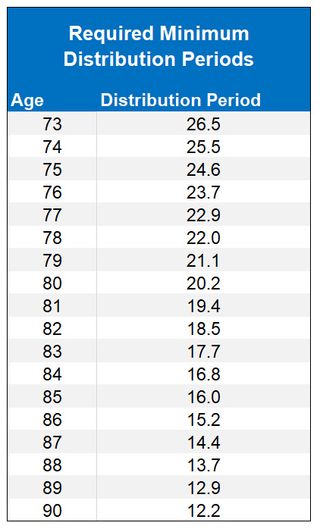What You Need to Know About Calculating RMDs for 2025
As 2025 begins, it's important to know how to calculate your required minimum distributions (RMDs) and be prepared for them to be higher this year than they were in 2024.


As the new year begins, many retirees age 73 or older will need to start thinking about when to take annual required minimum distributions (RMDs) from their pre-tax 401(k) accounts and traditional IRAs. And because the market ended the year on a very positive note, your 2025 RMD obligation could be higher than it was last year — which could increase your tax bill.
Higher returns equal higher RMDs
If a large portion of these accounts was invested in stocks, chances are that the value of your retirement portfolio ended 2024 significantly higher than it was at the end of 2023. That's largely because the S&P 500 closed 2024 with a total gain (including reinvestment of dividends) of 23.3%.
While most retirees will be happy with these results, they may also be hit with a higher total RMD amount this year. Why? Because the RMDs they’ll pay in 2025 are calculated based on the value of their accounts on December 31, 2024, the last day of trading.

Sign up for Kiplinger’s Free E-Newsletters
Profit and prosper with the best of expert advice on investing, taxes, retirement, personal finance and more - straight to your e-mail.
Profit and prosper with the best of expert advice - straight to your e-mail.
RMDs are taxable income. However, since the IRS has raised the standard deduction amount and adjusted income tax brackets for inflation, the amount you owe in taxes may not be as much as you may think, even if your RMD is higher.
If a good portion of your retirement nest egg is invested in a Roth IRA or Roth 401(k) account, there’s more good news: Not only are distributions from these accounts totally tax-free, but you’ll never have to take annual RMDs.
The process for calculating RMDs
While the process of calculating RMDs may seem mysterious, the methodology is rather simple.
Your yearly RMD is calculated using a formula based on the IRS’ Uniform Lifetime Table. The table and its associated distribution periods are based on complicated actuarial calculations of projected life expectancies. But basically, this table estimates the maximum number of years (also known as distribution periods) your retirement account may need to make RMDs to you and your surviving spouse (please see the note at the bottom of this article).

Your distribution period gets shorter every year, based on your age. For example, if you take your first RMD in 2025 at age 73, your distribution period is 26.5 years. When you turn 74, it will be 25.5 years. When you turn 90, it will be 12.2 years.
Will you or your surviving spouse need your retirement assets to last this long? Maybe, if longevity runs in your family. In any case, the distribution period is designed to gradually increase the percentage of RMDs from your retirement accounts over time without prematurely draining your nest egg should you live to a ripe old age.
Calculating your own RMDs
So how do you calculate your RMD for a given year? By dividing the value of each retirement account at the end of the previous year by the distribution period based on what your age will be in the year you take the RMD.
Here are two hypothetical examples using the table above. Say your IRA was worth $500,000 at the end of 2024, and you were taking your first RMD at age 73 this year. Your distribution amount would be $18,868 ($500,000 divided by 26.5). Likewise, if you were turning 85 in 2025, your RMD would be $31,250 ($500,000 divided by 16).
Making smart RMD decisions
Calculating RMDs is relatively simple. Where it can get complicated is figuring out which accounts you should take them from.
With 401(k) plan accounts, it’s pretty much a no-brainer. If you’re no longer actively participating in the plan (i.e., you’ve left the company or retired), most plan providers will calculate your annual RMD. However, it's generally your responsibility to make these withdrawals from your accounts in a timely fashion.
With other accounts, you have more flexibility and thus more options to consider. For example, if you have several traditional or rollover IRAs, you first need to calculate the RMD for each individual account. Many IRA custodians will do this for you. The challenge comes when you decide how much to withdraw from each account.
- You can take separate RMDs from each IRA
- You can take the total combined RMD from one IRA
- Or you can withdraw different amounts from several IRAs that, when combined, add up to the total RMD amount
Keep in mind that RMDs from 401(k) accounts don’t offset RMDs from IRAs or vice versa. You’ll need to take those as separate distributions.
Alternative RMD strategies
You may also want to consider other strategies for simplifying RMDs or reducing their taxable impact.
For example, you may be able to offset the taxable impact of RMDs from your IRA by donating some or all of the RMD amount as qualified charitable distributions (QCDs) to eligible nonprofit organizations. QCDs can lower or eliminate your taxable RMD amount, up to an aggregated maximum amount per year withdrawn from one or more IRAs. In 2025, this maximum is $108,000, and it will be adjusted for inflation every year. Keep in mind that QCDs are not eligible as charitable deductions.
Or, you might want to consolidate all of your various IRA and 401(k) accounts into a single rollover IRA with a custodian that calculates one aggregated RMD amount for you every year and automatically takes the distribution from the account on a date you specify.
All of these scenarios have retirement and tax planning consequences that aren’t always easy to figure out on your own. Working with an accountant and a financial adviser can help you figure out which distribution strategies make sense.
Note that the IRS Uniform Lifetime Table and the various RMD calculations discussed in this article apply only to unmarried retirement account owners; retirement account owners whose spouse is not their sole beneficiary; or retirement account owners whose spouse is their sole beneficiary and is not more than 10 years younger than the account owner. Different calculations are required if your spouse is your sole beneficiary and is more than 10 years younger than you. Learn more at the IRS website.
Related Content
Get Kiplinger Today newsletter — free
Profit and prosper with the best of Kiplinger's advice on investing, taxes, retirement, personal finance and much more. Delivered daily. Enter your email in the box and click Sign Me Up.

Chris Gullotti, CFP® is a financial adviser and Partner at Canby Financial Advisors in Framingham, MA. He has an MS in Financial Planning from Bentley College. He brings a big picture view to each client's situation and works cooperatively with his clients' other financial professionals, including family attorneys, tax professionals and insurance advisers.
Securities and advisory services offered through Commonwealth Financial Network®, Member FINRA/SIPC, a Registered Investment Adviser.
-
 Should You Add an Annuity to Your Retirement Portfolio in 2025?
Should You Add an Annuity to Your Retirement Portfolio in 2025?In need of some guaranteed income? An annuity may be the answer if you check off any of these boxes.
By Donna Fuscaldo Published
-
 More SECURE 2.0 Retirement Enhancements Kick in This Year
More SECURE 2.0 Retirement Enhancements Kick in This YearSaving for retirement gets a boost with these SECURE 2.0 Act provisions that are starting in 2025.
By Mike Dullaghan, AIF® Published
-
 Should You Add an Annuity to Your Retirement Portfolio in 2025?
Should You Add an Annuity to Your Retirement Portfolio in 2025?In need of some guaranteed income? An annuity may be the answer if you check off any of these boxes.
By Donna Fuscaldo Published
-
 More SECURE 2.0 Retirement Enhancements Kick in This Year
More SECURE 2.0 Retirement Enhancements Kick in This YearSaving for retirement gets a boost with these SECURE 2.0 Act provisions that are starting in 2025.
By Mike Dullaghan, AIF® Published
-
 Saving for Your Emergency Fund: As Easy as 1-3-6
Saving for Your Emergency Fund: As Easy as 1-3-6An emergency fund that can cover six months' worth of expenses is far easier to build if you focus on smaller goals at first.
By Anthony Martin Published
-
 Stock Market Today: Dow Slides 697 Points on Super-Hot Jobs Data
Stock Market Today: Dow Slides 697 Points on Super-Hot Jobs DataWhen the December nonfarm payrolls report hit the tape, there was no question which way stocks would go at Friday's opening bell.
By David Dittman Published
-
 Blowout December Jobs Report Puts Rate Cuts on Ice: What the Experts Are Saying
Blowout December Jobs Report Puts Rate Cuts on Ice: What the Experts Are SayingJobs Report The strongest surge in hiring since March keeps the Fed on hold for now.
By Dan Burrows Published
-
 Constellation Energy Stock Soars on Its $26 Billion Buy. Here's Why Wall Street Likes the Deal
Constellation Energy Stock Soars on Its $26 Billion Buy. Here's Why Wall Street Likes the DealConstellation Energy is one of the best S&P 500 stocks Friday after the utility said it will buy Calpine in a cash-and-stock deal valued at $26 billion.
By Joey Solitro Published
-
 Why Walgreens Is the Best S&P 500 Stock After Earnings
Why Walgreens Is the Best S&P 500 Stock After EarningsWalgreens stock is soaring Friday after the embattled pharmacy chain reported strong earnings and gave an upbeat outlook.
By Joey Solitro Published
-
 Delta Stock Remains a Strong Buy After Earnings
Delta Stock Remains a Strong Buy After EarningsDelta stock is soaring Friday after the air carrier beat earnings expectations and issued a strong outlook. Here's what investors need to know.
By Joey Solitro Published